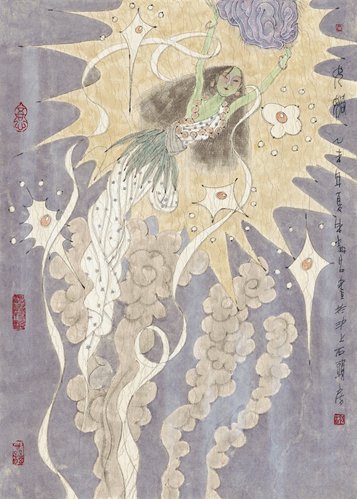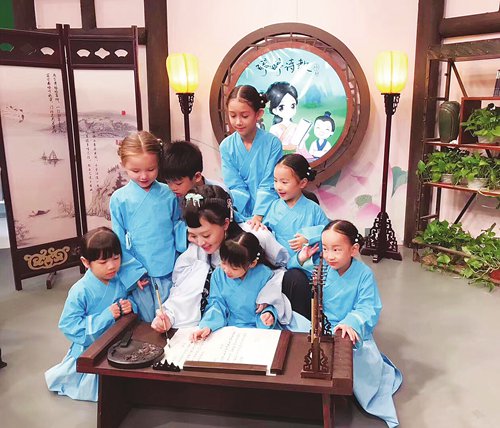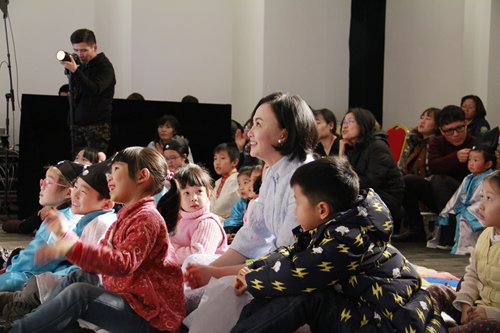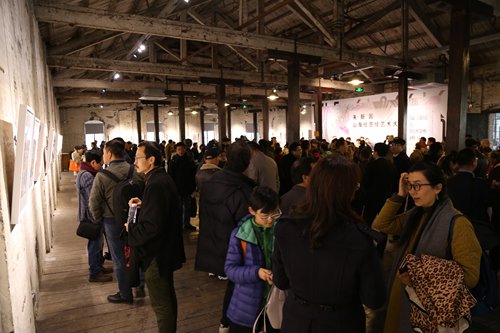METRO SHANGHAI / CITY PANORAMA
Chinese artists, educators hope to spread China’s ancient paintings, music and poetry to children
Returning to tradition
Last year, an article titled "Middle class chain of contempt about education" reported by Phoenix Weekly went viral on Chinese social media. The article described the multi-layered prejudices amongst Chinese middle class parents when it comes to whether their children were brought up and educated in an English-language environment. In the article, the interviewee saw that a little girl declined to be friends with a boy because he has no English name.
Cram schools targeting English competitions were once prevalent among Chinese students. And a variety of English language qualifications and certificates were once a stepping stone for job applicants to obtain a good job.
However, this phenomenon has been changing since the 18th Communist Party of China (CPC) National Congress, when the county's top leadership attached greater importance to the inheritance and development of China's own traditional culture.
In response, many Chinese artists and educators have created more works conveying Chinese traditional culture and catering to modern Chinese children to spread and popularize the culture.
Zhu Xinchang, a national first-level artist from the Shanghai Chinese Painting Academy, recently finished creating 100 Chinese paintings of the myths in Shan Hai Jing or The Classic Of Mountains and Seas, a Chinese classic book and a compilation of mythic geography and myths which have existed since the Warring States (475BC-221BC).
Zhu was not the first artist to visualize the Chinese myth compilation. But different from other artists who merely adopt the myths as a source of inspiration, Zhu hopes his new artwork will become popular among young people and help spread Chinese traditional culture and values among them.
Shan Hai Jing describes gods, goddesses and frightening monsters, such as Tianwu which has a human's face, eight heads, eight feet and eight tails, and Heluo, a fish which has one head and 10 bodies. Such creatures might sound horrible at first, but Zhu hopes these legendary mythical creatures will be adored by young viewers.
In order to cater to young people's aesthetic tastes, Zhu uses cartoon elements in his artworks, such as exaggerations and distortions. He designed bigger eyes for the Heluo like those in cartoons and designed brows and eyes for a giant named Xingtian, which he learned from Peking Opera masks.
"I'd like to turn these frightening creatures into ugly but lovable creations, instead of simply beautifying them," said Zhu, who wanted to create something more than what was conveyed in the text.
Rich imagination
Zhu spent two years creating the 100 paintings, each which took him two or three days to complete. He first heard the stories of Shan Hai Jing told by his parents when he was young and has always been greatly interested in this classic. After he became a professional Chinese painting artist, he has always been thinking about illustrating the mythology in the book.
"It is uncommon to illustrate Shan Hai Jing with Chinese paintings. Some recreations of the book are in the form of pictures printed from engraved plates. As far as I know, my series of the 100 Chinese paintings of Shan Hai Jing was the first in the nation," Zhu told the Global Times.
Since Shan Hai Jing covers an extensive range of contents, Zhu chose those most easy to convert into images and those he was personally interested in. He did not paint according to the order of the book but according to his own attraction. The first batch of paintings included Nüwa, who patches up the sky, and Jingwei, who fills the sea.

Before he started painting, Zhu also collected reference materials about Shan Hai Jing, including ancient picture books passed down from olden times. He copied some images from the old picture books, but later found his imagination was restrained. So he put away these old pictures and started painting using his own feelings and imagination.
What makes his paintings different from others and expected to be attractive to today's young people are the elements he learned from domestic and overseas cartoons such as Chinese cartoon Danao Tiangong (Uproar in Heaven) and Japanese cartoon Laputa: Castle in the Sky.
Zhu likes the rich imagination and lovely images in Hayao Miyazaki's cartoons. After viewing many of Miyazaki's cartoons, Zhu also added similar cartoon elements to his Chinese painting of Shan Hai Jing to attract today's young generation.
"Every era and every person have their own styles. I think artists should also make creations on the basis of inheriting traditions. I don't want my Chinese paintings to look old; I expect them to match modern people's aesthetics," Zhu said.
Zhu hopes his creation of the legendary characters can become a symbol of this era.

Poetry and prose
Apart from artists who turned Chinese classics into pictures, some composers and sinology educators have also dedicated themselves to spreading and popularizing Chinese ancient poems by composing music for them or turning them into catchy children's songs.
Chinese composer Gu Jianfen, 83, composed many popular songs for young people in the 1980s and 1990s, including "Girl Picking up Mushrooms", "Songs and Smiles", "Young People Come Together", "Mother in Candlelight" and "Green Leaves Appreciate for the Roots. " Many Chinese singers in the 1980s and 1990s such as Mao Amin, Na Ying, Sun Nan were her students.
In 2005, she started creating children's songs by composing for Chinese ancient poetry and prose. Over the past 12 years, she has created 50 children's songs with fine Chinese ancient literature works such as You Zi Yin (A Traveler's Song), San Zi Jing (The Three-character Classic) and Di Zi Gui (Standards for Students).
She told media that caring for children is one of the most import jobs for a country and for a family, and the inheritance of Chinese traditional culture is necessary for local children's growth.
In Shanghai, 34-year-old sinology educator Hu Tingting from East China's Jiangsu Province found that Chinese ancient poems are important to a child's growth and development after she had her own children; one is now 3 and the other only 18 months old.

"When I was pregnant, I often listened to classical Western music like Chopin and Mozart. But after they were born I found there was a shortage of options of Chinese children's songs. Most have been sung for generations and lack artistic conception. So I thought about composing for ancient poems and singing those to my children," said Hu.
Hu was brought up in a family where great importance was attached to Chinese traditional culture education. She excels at playing musical instruments, chess, Chinese calligraphy and painting.
Popularly known as Sister Tingting on China's social networking platforms and education apps, Hu has composed 150 children's songs of Chinese ancient poems since 2015, spreading Chinese traditional culture through modern platforms.
"The musical genres of my children's songs are diversified and we used a variety of musical instruments with different timbres to express different artistic conceptions and emotions of Chinese ancient poems, some of which are happy and some are sad," Hu told the Global Times.
"When I compose for the poem, I repeatedly polish them, one version after another, because the most important thing for creating children's songs is that I must create something children like," said Hu, who composed 20 versions, for example, for Tang Dynasty (618-907) poet Li Bai's Qiang Jin Jiu (Invitation to Wine).


Cram schools targeting English competitions were once prevalent among Chinese students. And a variety of English language qualifications and certificates were once a stepping stone for job applicants to obtain a good job.
However, this phenomenon has been changing since the 18th Communist Party of China (CPC) National Congress, when the county's top leadership attached greater importance to the inheritance and development of China's own traditional culture.
In response, many Chinese artists and educators have created more works conveying Chinese traditional culture and catering to modern Chinese children to spread and popularize the culture.
Zhu Xinchang, a national first-level artist from the Shanghai Chinese Painting Academy, recently finished creating 100 Chinese paintings of the myths in Shan Hai Jing or The Classic Of Mountains and Seas, a Chinese classic book and a compilation of mythic geography and myths which have existed since the Warring States (475BC-221BC).
Zhu was not the first artist to visualize the Chinese myth compilation. But different from other artists who merely adopt the myths as a source of inspiration, Zhu hopes his new artwork will become popular among young people and help spread Chinese traditional culture and values among them.
Shan Hai Jing describes gods, goddesses and frightening monsters, such as Tianwu which has a human's face, eight heads, eight feet and eight tails, and Heluo, a fish which has one head and 10 bodies. Such creatures might sound horrible at first, but Zhu hopes these legendary mythical creatures will be adored by young viewers.
In order to cater to young people's aesthetic tastes, Zhu uses cartoon elements in his artworks, such as exaggerations and distortions. He designed bigger eyes for the Heluo like those in cartoons and designed brows and eyes for a giant named Xingtian, which he learned from Peking Opera masks.
"I'd like to turn these frightening creatures into ugly but lovable creations, instead of simply beautifying them," said Zhu, who wanted to create something more than what was conveyed in the text.
Rich imagination
Zhu spent two years creating the 100 paintings, each which took him two or three days to complete. He first heard the stories of Shan Hai Jing told by his parents when he was young and has always been greatly interested in this classic. After he became a professional Chinese painting artist, he has always been thinking about illustrating the mythology in the book.
"It is uncommon to illustrate Shan Hai Jing with Chinese paintings. Some recreations of the book are in the form of pictures printed from engraved plates. As far as I know, my series of the 100 Chinese paintings of Shan Hai Jing was the first in the nation," Zhu told the Global Times.
Since Shan Hai Jing covers an extensive range of contents, Zhu chose those most easy to convert into images and those he was personally interested in. He did not paint according to the order of the book but according to his own attraction. The first batch of paintings included Nüwa, who patches up the sky, and Jingwei, who fills the sea.

A Chinese painting of Nüwa made by Zhu Xinchang Photo: Courtesy of Hu Tingting and No.8 Bridge Space of Art
Before he started painting, Zhu also collected reference materials about Shan Hai Jing, including ancient picture books passed down from olden times. He copied some images from the old picture books, but later found his imagination was restrained. So he put away these old pictures and started painting using his own feelings and imagination.
What makes his paintings different from others and expected to be attractive to today's young people are the elements he learned from domestic and overseas cartoons such as Chinese cartoon Danao Tiangong (Uproar in Heaven) and Japanese cartoon Laputa: Castle in the Sky.
Zhu likes the rich imagination and lovely images in Hayao Miyazaki's cartoons. After viewing many of Miyazaki's cartoons, Zhu also added similar cartoon elements to his Chinese painting of Shan Hai Jing to attract today's young generation.
"Every era and every person have their own styles. I think artists should also make creations on the basis of inheriting traditions. I don't want my Chinese paintings to look old; I expect them to match modern people's aesthetics," Zhu said.
Zhu hopes his creation of the legendary characters can become a symbol of this era.

A Chinese painting of Jingwei made by Zhu Xinchang
Poetry and prose
Apart from artists who turned Chinese classics into pictures, some composers and sinology educators have also dedicated themselves to spreading and popularizing Chinese ancient poems by composing music for them or turning them into catchy children's songs.
Chinese composer Gu Jianfen, 83, composed many popular songs for young people in the 1980s and 1990s, including "Girl Picking up Mushrooms", "Songs and Smiles", "Young People Come Together", "Mother in Candlelight" and "Green Leaves Appreciate for the Roots. " Many Chinese singers in the 1980s and 1990s such as Mao Amin, Na Ying, Sun Nan were her students.
In 2005, she started creating children's songs by composing for Chinese ancient poetry and prose. Over the past 12 years, she has created 50 children's songs with fine Chinese ancient literature works such as You Zi Yin (A Traveler's Song), San Zi Jing (The Three-character Classic) and Di Zi Gui (Standards for Students).
She told media that caring for children is one of the most import jobs for a country and for a family, and the inheritance of Chinese traditional culture is necessary for local children's growth.
In Shanghai, 34-year-old sinology educator Hu Tingting from East China's Jiangsu Province found that Chinese ancient poems are important to a child's growth and development after she had her own children; one is now 3 and the other only 18 months old.

Hu Tingting and children at a poetry teaching activity
"When I was pregnant, I often listened to classical Western music like Chopin and Mozart. But after they were born I found there was a shortage of options of Chinese children's songs. Most have been sung for generations and lack artistic conception. So I thought about composing for ancient poems and singing those to my children," said Hu.
Hu was brought up in a family where great importance was attached to Chinese traditional culture education. She excels at playing musical instruments, chess, Chinese calligraphy and painting.
Popularly known as Sister Tingting on China's social networking platforms and education apps, Hu has composed 150 children's songs of Chinese ancient poems since 2015, spreading Chinese traditional culture through modern platforms.
"The musical genres of my children's songs are diversified and we used a variety of musical instruments with different timbres to express different artistic conceptions and emotions of Chinese ancient poems, some of which are happy and some are sad," Hu told the Global Times.
"When I compose for the poem, I repeatedly polish them, one version after another, because the most important thing for creating children's songs is that I must create something children like," said Hu, who composed 20 versions, for example, for Tang Dynasty (618-907) poet Li Bai's Qiang Jin Jiu (Invitation to Wine).

Hu Tingting attends an activity with children.

Visitors at an exhibition of Zhu Xinchang's paintings
